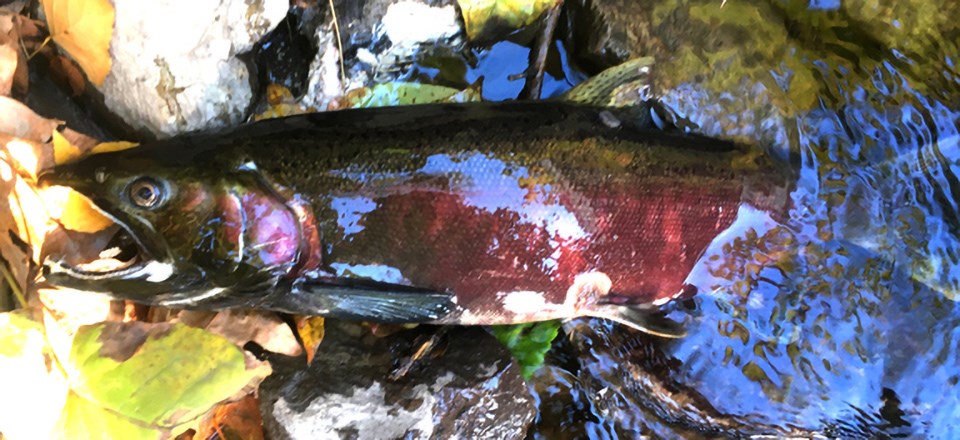Last updated: February 5, 2021
Article
Scientists Discover Silent Threats to Pacific Coast Salmon Populations

© Jeffrey S. Jensen / Photo 44019002 / 2017-11 / iNaturalist.org / CC BY-NC
January 2021 - For decades, coho salmon returning to spawn in urban Pacific Northwest streams have been mysteriously dying in the aftermath of large storms. Now, after a painstaking search for answers, a team of scientists have found the culprit: a previously undescribed chemical nicknamed 6PPD-quinone. It forms when 6PPD, a common tire rubber stabilizer, degrades in the environment. Even in tiny amounts it is very deadly to adult and juvenile coho. The team’s findings were recently published in Science.
Of course, tire residue in road runoff is not unique to the Pacific Northwest. The scientists checked for 6PPD-quinone in road runoff in Los Angeles and in urban creeks around San Francisco (in the East Bay and South Bay). They found it in both places. Marin County also has its share of busy roads. Could 6PPD-quinone-laced storm runoff be impacting federally endangered coho in Marin creeks?
So far, no one knows. Biologists haven’t seen fish listing or swimming in circles after storms as Seattle area biologists have. Nor have they seen carcasses of adult fish that died without spawning. But they also can’t rule it out. Fishery Biologist Michael Reichmuth notes the Redwood and Olema Creek coho runs are relatively small. His monitoring team doesn’t see a ton of live adult coho to begin with, and small numbers of carcasses would likely be gobbled up by other wildlife before anyone could find them. Still, biologists working with the larger Lagunitas Creek population haven’t seen signs of unhealthy fish either. Some speculate that perhaps Marin stormwater is better filtered (i.e., through soils) before it reaches our creeks versus in the Seattle area. If 6PPD-quinone is having an impact on Marin’s coho, it is on top of many other, bigger contributors to the region-wide decline. Agriculture, development, overfishing, and changing climate and ocean conditions have all taken their toll.
Meanwhile, scientists in California’s Central Valley noticed odd behavior and high mortality among juvenile Chinook salmon in multiple hatcheries just last winter. Eventually, they figured out that thiamine (Vitamin B1) baths immediately helped struggling fish. But why thiamine?
Researchers in other parts of the world have documented thiamine deficiencies in species that feed on large anchovy populations due to an enzyme anchovies produce. Sure enough, there was a notable anchovy boom off of the central California coast in 2018-2019 related to changing ocean conditions. Scientists’ theory is that returning female Chinook, having feasted on anchovies instead of their usual krill or sardines, passed thiamine deficiencies on to their eggs. They are still investigating the impact such deficiencies may have had outside of hatcheries, in other species like coho, and on survivors’ long-term health.
For more information
-
Tian Z, Zhao H, Peter KT, Gonzalez M, Wetzel J, Wu C, Hu X, Prat J, Mudrock E, Hettinger R, Cortina AE, Biswas RG, Kock FVC, Soong R, Jenne A, Du B, Hou F, He H, Lundeen R, Gilbreath A, Sutton R, Scholz NL, Davis JW, Dodd MC, Simpson A, McIntyre JK, Kolodziej EP. A ubiquitous tire rubber-derived chemical induces acute mortality in coho salmon. Science. 2021 Jan 8;371(6525):185-189. doi: 10.1126/science.abd6951.
-
Science news: Common tire chemical implicated in mysterious deaths of at-risk salmon
- NOAA Fisheries news: Researchers Probe Deaths of Central Valley Chinook, with Possible Ties to Ocean Changes
